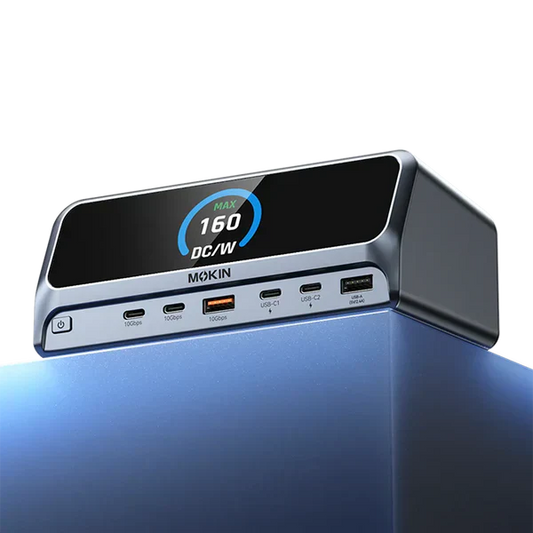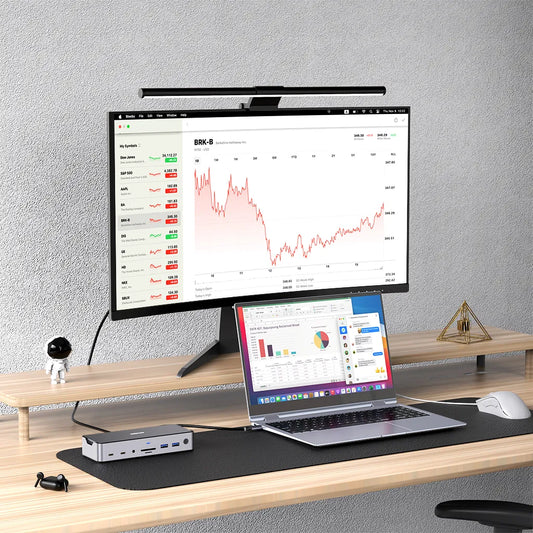USB Hub vs Docking Station: Which One is Right for You?
Contents
As life and work become more mobile, it's increasingly common to need USB hubs and docking stations for extra connectivity. However, many people are unsure about the differences between the two and may find it difficult to choose the right product. This article aims to clarify the specific differences between USB hubs and docking stations to help you make an informed decision when purchasing.
Section 1: What Is A USB Hub?
A USB C hub can be used as an extension adapter for USB C devices, allowing you to connect more devices to your laptop.It is compact and suitable for both work and travel. The USB C hub comes with additional USB-A ports, which are commonly used by many PC peripherals. Some of the more powerful hubs also feature SD/Micro SD slots, HDMI, DisplayPort, VGA, and Gigabit Ethernet ports, which provide further versatility to the user.

Section 2:How Does USB Hubs Work?
This device connects to your laptop via a single cable and features multiple ports, including USB-A, USB-C, SD/Micro SD slots, HDMI, DisplayPort, VGA, and Gigabit Ethernet ports, making it highly versatile. However, it only provides basic power for smaller peripherals like earphones and USB flash drives, so you'll still need your extra charger. The data transfer speeds vary depending on the hub's type. Basic USB 2.0 hubs max out at 480 Mbps, while USB 3.0 hubs offer a faster 5Gbps speed for transferring larger files. Meanwhile, USB 3.1 hubs provide a whopping 10Gbps speed, which is 20 times faster than USB 2.0. As USB hubs lack video output capabilities, you're limited to using your laptop's built-in screen.
Section 3:What Is Docking Station?
A docking station is a device that can expand the functionality of your laptop or computer, which will ultimately help to boost your productivity. It is also referred to as a port replicator and is considered a high-end connectivity solution. By connecting to your laptop through a single cable, usually USB-C or Thunderbolt, it provides additional ports or functions that your laptop or computer does not have. This means you can easily connect peripherals such as monitors, keyboards, mice, smartphones, and USB flash drives to your device. Docking stations often offer various ports, including USB ports, HDMI, DisplayPort, VGA, audio jacks, Ethernet ports, and PD charging ports for massive connectivity. It is an ideal solution for creating a more versatile workspace for individuals and especially helpful in reducing cable clutter around your laptop.
Section 4:How do Docking Stations Work?
A docking station is a device that connects to your laptop using a single cable and provides a range of port options, such as USB-A, USB-C, and Thunderbolt. These stations come with various connections, including Thunderbolt 4, USB4, and USB-C, and can connect different types of video displays, such as DisplayPort, HDMI, and VGA, at UHD resolutions like 4K, 5K, and 8K.
Before purchasing a docking station, ensure that it works with your laptop's ports and operating system. Check the specifications to verify that the docking station supports your laptop model and pay attention to all ports of your laptop, such as USB-C and Thunderbolt 3.
Docking stations generally come with Thunderbolt 3/4 and USB4/3 interfaces, allowing for data transfer speeds of up to 40Gbps and backward compatibility with USB3.1 (10Gbps) and USB3.0 (5Gbps).
Docking stations are designed with dedicated power delivery to charge your laptop. Ordinary models offer 65W output, while premium docks provide 96W to 150W charging capabilities comparable to stock laptop chargers. This efficient leveling up of productivity makes it a valuable addition to your work setup.
Section 5:What Are the Differences Between USB Hub vs Docking Station?
The difference between USB-C hubs and docking stations is minimal. Both of these devices are designed to expand peripheral connections. USB-C hubs primarily serve to increase the number of USB-A ports on a laptop and are usually powered by the laptop itself. Reliable hubs are compact and portable, making them ideal for professionals who travel frequently.
Docking stations are more advanced than USB-C hubs but are generally less portable and more expensive. They provide a variety of ports for diverse peripherals, creating a multi-functional work center. These ports include video ports such as HDMI, DisplayPort, mini-DisplayPort, VGA, and DVI, as well as Gigabit Ethernet, audio connections, SD/Micro SD card readers, and many USB-A or USB-C devices. Docking stations can power all these devices simultaneously, along with your laptop. Docking stations usually obtain power through a power outlet.
Section6:What Is the Best docking station?
The MOKiN 15-in-1 Docking Station is an all-encompassing connectivity solution that supports a single 8K or triple 4K displays, ensuring high-resolution visuals for any setup. It offers fast data transfer capabilities, a 1000Mbps Gigabit RJ45 Ethernet for speedy and reliable internet connection, and 100W pass-through charging to keep your devices powered. Additionally, it includes a switch and security slot for enhanced functionality and protection, all integrated into one compact device

Conclusion
The choice between a USB hub and a docking station depends on the intended use. A USB hub is more portable and lighter in weight, whereas a docking station provides a variety of ports for different peripherals, creating a multi-functional work center and offering strong power to keep working. The MOKiN 15-IN-1 Docking Station is the best choice for those who require high resolution and portability in their office work.

MOKiN 13-IN-1 USB-C Laptop Charging Station with 2.26-inch LCD Smart Display








